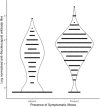Comparison of new and emerging SARS-CoV-2 variant transmissibility through active contact testing. A comparative cross-sectional household seroprevalence study
- PMID: 37093796
- PMCID: PMC10124829
- DOI: 10.1371/journal.pone.0284372
Comparison of new and emerging SARS-CoV-2 variant transmissibility through active contact testing. A comparative cross-sectional household seroprevalence study
Abstract
Historically SARS-CoV-2 secondary attack rates (SAR) have been based on PCR positivity on screening symptomatic contacts; this misses transmission events and identifies only symptomatic contacts who are PCR positive at the time of sampling. We used serology to detect the relative transmissibility of Alpha Variant of Concern (VOC) to non-VOC SARS-CoV-2 to calculate household secondary attack rates. We identified index patients diagnosed with Alpha and non-VOC SARS-CoV-2 across two London Hospitals between November 2020 and January 2021 during a prolonged and well adhered national lockdown. We completed a household seroprevalence survey and found that 61.8% of non-VOC exposed household contacts were seropositive compared to 82.1% of Alpha exposed household contacts. The odds of infection doubled with exposure to an index diagnosed with Alpha. There was evidence of transmission events in almost all households. Our data strongly support that estimates of SAR should include serological data to improve accuracy and understanding.
Copyright: © 2023 Gaskell et al. This is an open access article distributed under the terms of the Creative Commons Attribution License, which permits unrestricted use, distribution, and reproduction in any medium, provided the original author and source are credited.
Conflict of interest statement
The authors have declared that no competing interests exist.
Figures
References
-
- Águila-Mejía JD, Wallmann R, Calvo-Montes J, Rodríguez-Lozano J, Valle-Madrazo T, et al.. Secondary Attack Rate, Transmission and Incubation Periods, and Serial Interval of SARS-CoV-2 Omicron Variant, Spain—Volume 28, Number 6—June 2022. —Emerging Infectious Diseases journal—CDC. [cited 2022 May 24]; Available from: https://wwwnc.cdc.gov/eid/article/28/6/22-0158_article - PMC - PubMed
Publication types
MeSH terms
Supplementary concepts
Grants and funding
LinkOut - more resources
Full Text Sources
Medical
Miscellaneous



